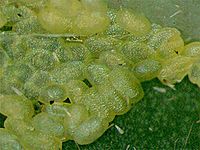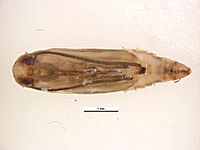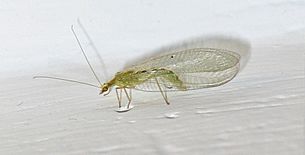Diamondback moth facts for kids
Quick facts for kids Diamondback moth |
|
|---|---|
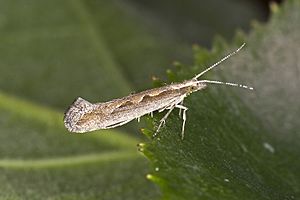 |
|
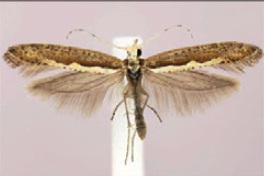 |
|
| Scientific classification | |
| Synonyms | |
|
List
|
The diamondback moth (Plutella xylostella), also known as the cabbage moth, is a small moth. It belongs to the family Plutellidae. This moth is usually grayish-brown. It sometimes has a cream-colored band on its back that looks like a diamond. This is how it got its name.
This moth might have first appeared in Europe, South Africa, or the Mediterranean area. But now, you can find it all over the world. It has a fast life cycle, taking only about 14 days at 25°C. These moths can also have many babies and fly very far.
Diamondback moths are seen as pests because they eat the leaves of cabbage-like plants. These plants include broccoli, cabbage, and cauliflower. Some plants are better hosts for the moth than others. Scientists have suggested using a plant called wintercress as a "trap crop." Moths love to lay eggs on wintercress. However, their young (larvae) cannot survive on it.
In the past, people used chemicals called pesticides to kill these moths. But the moths have become resistant to many common chemicals. Because of this, new ways to control them are being explored. These include using natural enemies, new chemicals, and different planting methods. The goal is to reduce the damage these moths cause.
Contents
What the Diamondback Moth Looks Like
This small moth is gray and brown. You can often spot it by a cream-colored band on its back. This band can form a diamond shape. The diamondback moth has a wingspan of about 15 millimeters (about half an inch). Its body is about 6 millimeters long.
Its front wings are narrow and brownish-gray. They are lighter along the front edge and have tiny dark spots. A wavy, cream-colored stripe on the back edge sometimes narrows. This forms one or more light-colored diamond shapes. This is why it's called the diamondback moth. The back wings are narrow and light gray. They have a wide fringe of hairs. When you look from the side, the tips of the wings turn up a little. The moth also has noticeable antennae.
Where Diamondback Moths Live
The diamondback moth lives all over the world. You can find it in Europe, Asia, Africa, the Americas, Australia, New Zealand, and the Hawaiian Islands. It likely started in Europe, South Africa, or the Mediterranean region. We don't know its exact travel path.
In North America, it was first seen in Illinois in 1854. By 1883, it was in Florida and the Rocky Mountains. Diamondback moths cannot survive cold winters very well. But they were found in British Columbia by 1905. Now, they live in several parts of Canada. Each spring, winds carry them to colder areas.
Reproduction: Laying Eggs
How Moths Choose Where to Lay Eggs
Female diamondback moths prefer to lay their eggs on cabbage plants. These plants belong to the species Brassica oleracea. Females lay eggs only on the leaves of cabbage plants. They don't seem to care if the leaves are young or old.
However, females are more likely to lay eggs on a plant that already has larvae on it. It's not fully clear why they do this. Scientists think that infested plants might give off a special smell that attracts them.
Female moths use both taste and smell to decide where to lay their eggs. If they can't taste the plant, or if they can't taste and smell it, they won't lay eggs. But if they can only taste the plant, they will still lay eggs.
Host Plant Selection for Egg Laying
Host Plants
Choosing the right host plant is very important for diamondback moths. They spend most of their lives near their host plant. The diamondback moth lays its eggs only on plants in the Brassicaceae family. Almost all vegetables in this family are attacked. However, some are preferred more than others.
These include:
Many wild plants in this family also act as hosts. This is especially true early in the season when farm crops are not ready. Female moths that lay eggs can recognize certain chemicals in host plants. These chemicals are called glucosinolates and isothiocyanates. They are common in the Brassicaceae family. These chemicals make the moths want to lay eggs. They even lay eggs on paper if these chemicals are on it.
One plant with these egg-laying chemicals is wintercress (Barbarea vulgaris). Female moths do lay eggs on wintercress. But the baby larvae die because of other natural chemicals in the plant called saponins.
Smell
Female diamondback moths show different behaviors before laying eggs. Both virgin and mated females can smell host plants equally well. But pregnant females are more attracted to the smell. This is because they are looking for a place to lay their eggs.
Diamondback moths are active at night. They use their sense of smell to find host plants. They also move their antennae around to search for the host smell. If the host smell is weak or missing, the moth spends more time moving its antennae. They move their antennae more when near a healthy plant than a damaged one. This shows that damaged leaves give off a stronger smell.
Taste and Touch
Moths touch the leaf with their antennae. This behavior is likely used to taste the host plant. After tasting, the moth will sweep its egg-laying tube (ovipositor) across the spot. This helps it gather more information about the host.
Female moths lay their eggs one at a time. They prefer small cracks or grooves on leaves. These grooves might offer protection and easy access to food. However, grooves on leaves don't decide when eggs are laid. They might just help with where the eggs are placed.
Life cycle
Eggs
The eggs are oval and flat. They are about 0.44 millimeters long and 0.26 millimeters wide. At first, they are yellow or pale green. Later, they turn darker. Females lay eggs one by one or in small groups of two to eight. They place them in small dips on the leaf surface. A female can lay up to 300 eggs in total. But on average, they lay about half that amount. The larvae hatch from the eggs in about six to seven days.
Larvae
The larvae have four stages of growth, called instars. Each stage lasts about four days. The larvae's body gets narrower at both ends. Young larvae are colorless and have a few short black hairs. Later, they become pale or emerald green with black heads. They have five pairs of leg-like parts called prolegs. One pair sticks out from the back, forming a "V" shape.
The larvae are very active. If disturbed, they might wiggle a lot, move backward, or spin a silk thread to hang from. In their first stage, larvae feed inside the leaf. This is called "leaf mining." But they are so small that these tunnels are hard to see. After this, they come out to shed their skin (moult). Then they eat the underside of the leaf. Their chewing creates irregular damaged spots. The top layer of the leaf often stays whole. These damaged spots look like "window panes."
How Sex Pheromones Affect Larvae
When female diamondback moths lay eggs, they leave some of their sex pheromones on the leaves. Larvae are attracted to a main part of this pheromone. For larvae, this pheromone helps them find food. It's not for mating. They use it to find healthy food and avoid other species competing for food. After their fourth growth stage, larvae are no longer attracted to the sex pheromone for food.
Pupa
The yellowish pupae are about 8 millimeters long. They are wrapped in a loose silk cocoon. You usually find them on the lower or outer leaves of the food plant. But on cauliflower and broccoli, they might be found in the flower heads. A pupa can sometimes fall off its host plant. The pupal stage lasts about eight days on average. It can range from five to fifteen days. Before the adult moth comes out, the pupa changes from yellowish to a browner color.
Adult
Female adult moths live for about three to four weeks. Males live for a shorter time. These moths are not strong fliers. They rarely fly higher than 2 meters (about 6.5 feet) above the ground. They also don't fly long distances on their own. However, they can be carried long distances by the wind.
Diamondback moths spend the winter as adults among old plant parts in fields. In warmer areas, active adults can be seen during warm periods in winter. They cannot survive very cold winters. So, they fly back to colder areas each spring, carried by the wind. Moths are usually active at dusk and at night. They feed on the flowers of cabbage-like plants. But during large outbreaks, they can also fly in the afternoon.
Enemies
Predators and Parasites
Farmers are trying to find natural ways to get rid of the diamondback moth. This is especially important because the moths have become resistant to pesticides. Common enemies of the moth include tiny wasps called Trichogramma chilonis and Cotesia plutella. Another enemy is the lacewing (Chrysoperla carnea).
Lacewings eat the eggs and young larvae. The tiny wasps only lay their eggs inside the moth's eggs. These natural enemies can recognize the moth's sex pheromones. They also recognize the smell of larval waste and green leaf smells from cabbage. Cabbage smells mixed with the sex pheromone are very good at attracting these predators and parasites. They then eat the diamondback larvae and eggs.
Mating
Pheromones
Female diamondback moths release a special scent called a sex hormone or pheromone. This scent attracts males. Males have a strong sense of smell that can detect these female pheromones from far away. Females release pheromones, and mating happens near the host plant. The plant's smell might even help with this process.
The weather affects the size of the diamondback moth. But even a few days of high temperatures can reduce how many babies females can have. High temperatures might lower the amount of sex pheromones females release. This could delay mating.
Number of Mates
Some animals benefit from mating many times. This can lead to more offspring and a wider variety of genes. For some species, females live longer if they mate multiple times. This is because they get nutrients from the males during mating.
Diamondback moths can mate more than once. However, mating only once seems more common. When male moths mate more than once, they don't get any benefits. In fact, their health and lifespan decrease. Their chances of successful reproduction also go down. Females who mate with males that have mated many times also live shorter lives and have fewer babies. Mating time also gets longer when males mate multiple times. Longer mating times are bad for diamondback moths. It makes them more likely to be eaten by predators or get hurt during mating.
While male diamondbacks can mate many times, females clearly prefer to mate only once. One reason is that a female only needs one mating to fertilize all her eggs. She stores extra sperm from that single mating. Also, a female can stop unwanted multiple matings by forming a special plug.
Interaction with Humans
Pest of Crops
The larvae of the diamondback moth damage leaves, buds, flowers, and seeds of farm plants. Even though the larvae are small, there can be many of them. They can eat almost all of the leaf tissue, leaving only the veins. This is very harmful to young plants. It can also stop cabbage, broccoli, and cauliflower from forming heads. If larvae are found in the flower heads, the produce might be completely rejected.
The diamondback moth is a big problem in areas that don't have very cold winters. Cold winters help reduce adult moth activity and kill off moths that are spending the winter. It's a particularly big issue in China. Chinese cabbage is a very important vegetable crop there.
Pesticide Resistance
The widespread use of insecticides in the 1950s might be why the diamondback moth doesn't have many natural enemies. The diamondback moth wasn't known to be resistant to DDT until 1953. But many different insecticides started being used in the late 1940s. By the 1980s, the moths had become resistant to pyrethroid chemicals.
Using fewer broad-spectrum insecticides, especially pyrethroids, can help natural enemies survive. These enemies include tiny wasps like Microplitis plutellae, Diadegma insulare, and Diadromus subtilicornis.
The diamondback moth was the first insect found to be resistant to a biological control called Bt toxin. This toxin comes from a bacteria called Bacillus thuringiensis. Bt toxin is poisonous to insects when they eat it, but not to mammals. So, it was used for low levels of moth infestation. Research shows that the diamondback moth has a gene that makes it resistant to four types of Bt toxin. The cabbage looper is the only other insect to become resistant to Bt toxin in farm settings, specifically in greenhouses.
Other Controls
Rainfall and watering can kill larvae. A farming method called intercropping in China can help reduce the number of diamondback larvae on plants. This means planting two or more crops together. However, it doesn't always reduce the damage. Scientists have suggested using sex pheromones and plant smells to attract and trap diamondback moths. This could be a way to control them with chemicals.
Climate Effects
Changes in seasonal temperature affect the size of diamondback moths. Warmer temperatures lead to smaller moths. Colder temperatures lead to larger moths. Larger moths can fly better, live longer, and have more babies than smaller moths. So, long-distance migration usually happens in the spring. This is because more large moths are available and able to fly then.
Integrated Pest Control
Potential Cultural Practices
First, planting different crops together (intercropping) is good for reducing pests. This increases the variety of life in the field. Planting two or more crops in one field can reduce the need for fertilizers or pesticides. This can make farming more profitable and produce better quality crops. For example, planting tall or short red clover with cabbage can reduce the number of eggs laid by the diamondback moth.
Second, the timing of planting can be important. Pest populations are affected by the seasons. For instance, during wet times, the diamondback moth infection rate is very low. So, growing cabbage-like plants during wet seasons can help reduce pesticide use.
Third, farmers can use crop rotation. This means growing different types of vegetables in a field each season. For example, cabbage-like vegetables can be rotated with melons, fruits, onions, and garlic. This breaks the food chain for the diamondback moth.
Also, keeping cabbage fields clean is a simple but important way to control pests. A clean growing area can greatly lower the chance of infection. Before farming, the soil can be plowed and left in the sun for at least a week. This helps get rid of diamondback moths and improves the soil quality.
Potential Physical and Mechanical Practices
Blue-light traps can catch many adult diamondback moths. Setting up these traps above cabbage plants can help slow down the spread of resistant moths.
Potential Biological Control Options
1. Introducing natural enemies that eat the larvae can reduce their numbers. These enemies usually have a noticeable effect later in the crop's growth. They can kill up to 70% of the moths. Wasps and spiders are common predators. Bringing in natural predators can be a very effective way to manage pests and keep ecosystems healthy.
2. Scientists can also use genetic methods. For example, a gene in the diamondback moth can be changed. This is a very precise method. A UK biotechnology company called Oxitec did field tests in New York state. They released genetically modified male moths. When these GM males mated with wild females, all the resulting female larvae died. The male larvae passed on the gene to their offspring. About half of the GM males died in each generation. This means the gene would disappear in a few years and not stay in the wild.
Potential Chemical Control Options
Chemical control means using pesticides to protect cabbage fields. This is done when the number of larvae gets too high. Pesticides are used during the time when the plants are growing quickly. This helps prevent large numbers of diamondback moths from developing. It is most effective to use insecticide when there are many larvae. Since pesticides are hard to kill larvae and pupae, enough pesticides must be used. Make sure the plants are fully covered. The diamondback moth is most active at dusk or at night. This is when insecticides work best. Also, avoid spraying flowering plants. This helps protect bees and other insects that pollinate plants.
Images for kids
See also
 In Spanish: Palomilla dorso de diamante para niños
In Spanish: Palomilla dorso de diamante para niños


